Each quarter, we invite VMN chapters to share stories of their impacts, accomplishments, and awards. This quarter, we received an especially high number of submissions! Do take the time to read them all so that you may be inspired by these tremendous volunteers and their impactful projects!
 A member of the Emmanuel Christian Fellowship Team closes up a bluebird nest box. Photo by VMN Northern Neck Chapter.
A member of the Emmanuel Christian Fellowship Team closes up a bluebird nest box. Photo by VMN Northern Neck Chapter. Northern Neck Chapter Reaches Out
Community and Master Naturalist Cooperation
--Contributed by Pam Narney, VMN Northern Neck Chapter
Northern Neck Master Naturalists Camille Grabb and Ellen Hunter united with members of Emmanuel Christian Fellowship in Warsaw, VA to build a nature trail that connects church members to their cemetery. A quiet walk through the nature trail provides time for contemplation and rest from the cares of the outside world. The trail, created and maintained with cooperative efforts of the church community and the Master Naturalists, is an ongoing chapter activity involving many NNMN volunteers.
Out of this connection grew other Master Naturalists activities.
Anne Parker will botanize the area identifying the plants, native and invasive. The church members are excited to learn about and plant native plants.
Virginia Master Naturalists aided the Emmanuel community which won a grant for six complete Bluebird boxes from the Virginia Bluebird Society. Master Naturalists Pam and John Narney provided expertise on placement of the boxes and trained the church volunteers. Verlane Mack and her friends put the boxes together while Pastor Mike Taylor provided the manpower to pound the support poles into the ground. Pam and John are the Richmond and Westmoreland County Coordinators for the Virginia Bluebird Society.
Community and Master Naturalist Cooperation
--Contributed by Pam Narney, VMN Northern Neck Chapter
Northern Neck Master Naturalists Camille Grabb and Ellen Hunter united with members of Emmanuel Christian Fellowship in Warsaw, VA to build a nature trail that connects church members to their cemetery. A quiet walk through the nature trail provides time for contemplation and rest from the cares of the outside world. The trail, created and maintained with cooperative efforts of the church community and the Master Naturalists, is an ongoing chapter activity involving many NNMN volunteers.
Out of this connection grew other Master Naturalists activities.
Anne Parker will botanize the area identifying the plants, native and invasive. The church members are excited to learn about and plant native plants.
Virginia Master Naturalists aided the Emmanuel community which won a grant for six complete Bluebird boxes from the Virginia Bluebird Society. Master Naturalists Pam and John Narney provided expertise on placement of the boxes and trained the church volunteers. Verlane Mack and her friends put the boxes together while Pastor Mike Taylor provided the manpower to pound the support poles into the ground. Pam and John are the Richmond and Westmoreland County Coordinators for the Virginia Bluebird Society.
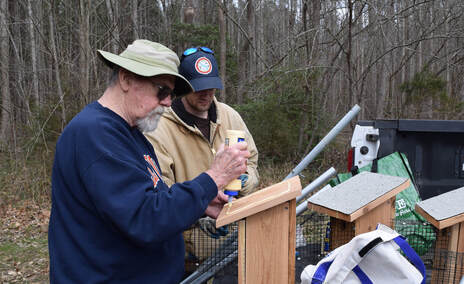 Volunteer works with the Environmental Director of the Rappahannock Tribe to prepare bluebird nest boxes at for installation at Fone's Cliffs.
Volunteer works with the Environmental Director of the Rappahannock Tribe to prepare bluebird nest boxes at for installation at Fone's Cliffs. The Narneys also worked with the Rappahannock Tribe’s Environmental Director, Jack Ryan, and the tribe’s Virginia Bluebird Society grant to install Bluebird boxes on tribal lands at Fone’s Cliffs. For now, these Bluebird trails are in remote areas and will be monitored by Jack Ryan and the tribe.
Camille, Ellen, Anne and other VMNNs will catalog plants at several of the tribe’s locations.
These Northern Neck Master Naturalists have created lasting ties to their communities.
Camille, Ellen, Anne and other VMNNs will catalog plants at several of the tribe’s locations.
These Northern Neck Master Naturalists have created lasting ties to their communities.
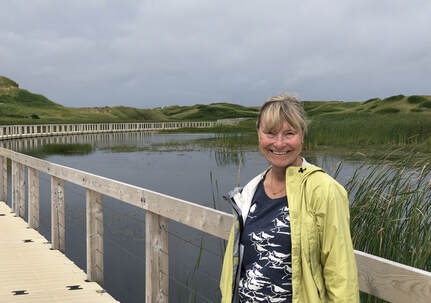 Martina Coker, VMN volunteer in the Eastern Shore Chapter. Photo by John Coker.
Martina Coker, VMN volunteer in the Eastern Shore Chapter. Photo by John Coker. Martina Coker, principal founder and chief steward of the Edward S Brinkley Nature Preserve
Contributed by Paul Anderson, VMN Eastern Shore Chapter
In 2019, Martina Coker was part of a small group that encouraged the establishment of the Edward S. Brinkley Nature Preserve as a Master Naturalist project from Northampton County property that was originally slated to become a public golf course.
Since that time Martina has played a major role towards maintenance and improvements to the Edward S. Brinkley Nature Preserve, turning it into a beautiful asset for the people of the County and visitors from throughout Virginia. The Preserve has become well known for its great variety of birds and wildlife that can easily be observed, and protects several different habitats including open meadows, maritime forest and saltwater marsh. Other improvements include a man-made freshwater pond with two wooden lakeside platforms built to give birders, photographers, and other visitors good views of seasonally migrating and year-round populations of ducks and geese, as well as an island where white ibis flocks commonly congregate.
From early on Martina performed major work behind the scenes to find the funds necessary for various projects that would improve Preserve access for visitors to explore the varied ecosystems supporting birds, insects, plant life and mammals. This included re-construction of the Seaside Walkway and Boardwalk which traverses the maritime forest and low-lying swamp and marsh allowing access to an educational marsh overlook platform which includes a cell phone holder allowing any visitor the opportunity to contribute their photos for a long-term citizen science project on coastal change. Through grant funding provided by the NOAA Coastal Zone Management and Martina’s leadership, the boardwalk construction project was adopted by a group of Eastern Shore Chapter of Master Naturalists, who under Martina’s guidance completed the project in the grant allotted time.
Since its inception, Martina has worked hard and effectively on overall Preserve maintenance and improvement. As Brinkley Steward Chair she coordinated the volunteer team of Eastern Shore Master Naturalists who perform weekly stewardship walks and report on any wildlife observations, Preserve maintenance needs, and ensure that the Seaside Walkway/Boardwalk is swept and kept clear of debris. Martina then arranges for these reports to be distributed to all Preserve stewards and communicates with the County to ensure that all necessary maintenance is performed.
Under her leadership as the Committee Chair, the following improvement projects were implemented.
The final touch will be a pavilion where visitors can sit down and relax while enjoying the views. This construction project will be funded through Northampton County Tourism Infrastructure Grants. Martina deserves recognition for her vision identifying the above improvements, as well as her role in managing the Eastern Shore Master Naturalist stewardship team and coordinating maintenance of the Preserve.
Contributed by Paul Anderson, VMN Eastern Shore Chapter
In 2019, Martina Coker was part of a small group that encouraged the establishment of the Edward S. Brinkley Nature Preserve as a Master Naturalist project from Northampton County property that was originally slated to become a public golf course.
Since that time Martina has played a major role towards maintenance and improvements to the Edward S. Brinkley Nature Preserve, turning it into a beautiful asset for the people of the County and visitors from throughout Virginia. The Preserve has become well known for its great variety of birds and wildlife that can easily be observed, and protects several different habitats including open meadows, maritime forest and saltwater marsh. Other improvements include a man-made freshwater pond with two wooden lakeside platforms built to give birders, photographers, and other visitors good views of seasonally migrating and year-round populations of ducks and geese, as well as an island where white ibis flocks commonly congregate.
From early on Martina performed major work behind the scenes to find the funds necessary for various projects that would improve Preserve access for visitors to explore the varied ecosystems supporting birds, insects, plant life and mammals. This included re-construction of the Seaside Walkway and Boardwalk which traverses the maritime forest and low-lying swamp and marsh allowing access to an educational marsh overlook platform which includes a cell phone holder allowing any visitor the opportunity to contribute their photos for a long-term citizen science project on coastal change. Through grant funding provided by the NOAA Coastal Zone Management and Martina’s leadership, the boardwalk construction project was adopted by a group of Eastern Shore Chapter of Master Naturalists, who under Martina’s guidance completed the project in the grant allotted time.
Since its inception, Martina has worked hard and effectively on overall Preserve maintenance and improvement. As Brinkley Steward Chair she coordinated the volunteer team of Eastern Shore Master Naturalists who perform weekly stewardship walks and report on any wildlife observations, Preserve maintenance needs, and ensure that the Seaside Walkway/Boardwalk is swept and kept clear of debris. Martina then arranges for these reports to be distributed to all Preserve stewards and communicates with the County to ensure that all necessary maintenance is performed.
Under her leadership as the Committee Chair, the following improvement projects were implemented.
- The parking lot was moved 500 yards north to allow for sunrise to sunset access every day of the week. It has been expanded and resurfaced twice since it was installed.
- A network of trails giving easy access to all parts of the Preserve was established and is now maintained by Northampton County.
- In 2021 Martina worked with the Department of Conservation and Recreation (DCR) for park signage including the donation and installation of introductory signage at the Preserve entrance.
- Further interpretive and directional signage was created and put in place in 2022.
A native habitat area for the benefit of pollinators and birds was planted in autumn 2023 with a variety of native plants, including Milkweed, Bee Balm, Virginia Mountain Mint, Black-eyed Susan, Golden Alexander, Seaside Goldenrod, and others. We are optimistic that we will see the results this summer. - Martina has been pushing for the removal of two temporary storage buildings located near the entrance to the Preserve. This has now been completed with plans for the installation of proper bathrooms scheduled to take place in 2024.
The final touch will be a pavilion where visitors can sit down and relax while enjoying the views. This construction project will be funded through Northampton County Tourism Infrastructure Grants. Martina deserves recognition for her vision identifying the above improvements, as well as her role in managing the Eastern Shore Master Naturalist stewardship team and coordinating maintenance of the Preserve.
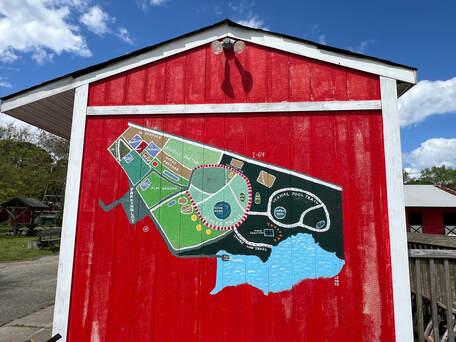
Fun at Blue Bird Gap Farm
--Contributed by Linda Boone, VMN Peninsula Chapter
2023 ended with a solid foundation for our projects to grow and improve at Blue Bird Gap Farm, a public park in Hampton. Jacqueline Keener Weatherford ‘s fellow graduate students from George Mason University completed their four month assessment and their recommendations from this Assistive Technology Report and study of the farm, including the back 20 acres of trails. Jacqueline is the lead of this project called ATTA Farm ( Accessible Trails To All).
In March, an access survey of BBGF was sent to the families of special education city students. With this demographic information and the recommendation of GMU’s assessment, we, as Jacqueline states, are not just shooting in the dark, and now we know how to make the farm more accessible.
One of the recommendations was to have a map of the farm and sitting areas in the what’s now the Welcome Center. The fun starts! The words “Welcome Center ” and a huge map of the farm were painted on the exterior of the building by Stan Stallnaker, a local artist, and Peninsula Master Naturalists Meera Rao and Linda Boone. There was immediate appreciation from the visitors with this addition. Linda and her family also painted a mural inside the building, including a chair and a bench (bench featuring pollinator education) in a farm theme.
Our first outdoor sensory display is located in Adventure Woods, a children’s area, which displays a “Protect Our Watershed” theme.
To celebrate Earth Day “Party for the Planet” was sponsored by Hampton Clean City on April 20, and had 450 attendees. PMN presented oyster information, complete with local shellfish in an aquarium. We assisted Hampton Waterway Restoration Project in their watershed/litter education, which related to each other’s displays. The children enjoyed using a litter stick to pick up trash in the baby pool while leaving the natural habitat specimens.
More fun is to come next weekend with a goat walk. The naturalist will pair up to take the goats around the farm. This will be fun for the naturalist and enriching for the goats & visitors, as well as helping grounds maintenance, as the goats eat poison ivy!
More fun will happen in May as the naturalist will sponsor a monthly educational event called “Fun Facts at the Farm”. PMN, Lloyd Spencer, and Master Gardeners will present spring planting information.
We are grateful for the faithful few who continue the monthly trail maintenance. We now have 54 new saplings to monitor which were planted by volunteers in March including PMN and sponsored by Hampton Clean City . There’s always fun to be had at the farm.
--Contributed by Linda Boone, VMN Peninsula Chapter
2023 ended with a solid foundation for our projects to grow and improve at Blue Bird Gap Farm, a public park in Hampton. Jacqueline Keener Weatherford ‘s fellow graduate students from George Mason University completed their four month assessment and their recommendations from this Assistive Technology Report and study of the farm, including the back 20 acres of trails. Jacqueline is the lead of this project called ATTA Farm ( Accessible Trails To All).
In March, an access survey of BBGF was sent to the families of special education city students. With this demographic information and the recommendation of GMU’s assessment, we, as Jacqueline states, are not just shooting in the dark, and now we know how to make the farm more accessible.
One of the recommendations was to have a map of the farm and sitting areas in the what’s now the Welcome Center. The fun starts! The words “Welcome Center ” and a huge map of the farm were painted on the exterior of the building by Stan Stallnaker, a local artist, and Peninsula Master Naturalists Meera Rao and Linda Boone. There was immediate appreciation from the visitors with this addition. Linda and her family also painted a mural inside the building, including a chair and a bench (bench featuring pollinator education) in a farm theme.
Our first outdoor sensory display is located in Adventure Woods, a children’s area, which displays a “Protect Our Watershed” theme.
To celebrate Earth Day “Party for the Planet” was sponsored by Hampton Clean City on April 20, and had 450 attendees. PMN presented oyster information, complete with local shellfish in an aquarium. We assisted Hampton Waterway Restoration Project in their watershed/litter education, which related to each other’s displays. The children enjoyed using a litter stick to pick up trash in the baby pool while leaving the natural habitat specimens.
More fun is to come next weekend with a goat walk. The naturalist will pair up to take the goats around the farm. This will be fun for the naturalist and enriching for the goats & visitors, as well as helping grounds maintenance, as the goats eat poison ivy!
More fun will happen in May as the naturalist will sponsor a monthly educational event called “Fun Facts at the Farm”. PMN, Lloyd Spencer, and Master Gardeners will present spring planting information.
We are grateful for the faithful few who continue the monthly trail maintenance. We now have 54 new saplings to monitor which were planted by volunteers in March including PMN and sponsored by Hampton Clean City . There’s always fun to be had at the farm.
 Sample DEI informational slide from the basic training course, class #13, prepared by Cheryn App and Cal Meadows.
Sample DEI informational slide from the basic training course, class #13, prepared by Cheryn App and Cal Meadows. DEI Taken Up a Notch
Contributed by the VMN Riverine Chapter training committee
The Riverine chapter’s Basic Training Course has always included a module on Diversity, Equity and Inclusion (DEI), but in 2024 two members of our training committee took the initiative to expand and connect DEI to the other training lessons and better show its applicability to our work. Cheryn Rapp and Cal Meadows developed and presented a brief talk on DEI at the beginning of each class, relevant to the topic of that class. The presentations usually consisted of three slides: one on a relevant topic (e.g., Environmental Justice was presented in the Ecology class; Black History month and Black botanists in the botany class; queer ecology and gender inclusivity in the ornithology class) plus two more slides with many suggestions on how VMNs can get involved and further reading, resources and recommendations on that night’s topic.
At the end of the 2024 class in April, we asked each class member to describe something they had learned from the DEI presentations and how they planned to use it. Here are a few of the responses:
“...I had never heard before that there is a higher percentage of “intact” land due to indigenous management compared to land protected by countries. ... I would like to find opportunities to learn from indigenous land managers and help increase recognition of their knowledge of land management strategies.”
“...I also appreciated the interactive discussion surrounding equity vs equality. I plan to keep this in mind when thinking about how to make events accessible for everyone (keeping things around public transit, wheelchair accessible, free, etc)."
“… Queer Ecology: Avoid binary notions like “alive and not alive” “Natural and unnatural” etc. Stress that nature is in a continuous state."
“...I was reminded of the concept of psychological safety as it relates to learning which was introduced before the class on Interpretation. It is important that everyone feels safe and supported in a learning environment because it enhances learning and it may encourage a lifelong interest in the topic if learners are allowed to thrive.”
As he was leaving the classroom, one of our guest instructors, Sammy Zambon from DCR, stopped to tell us how impressed he was with the DEI presentation at the beginning of class. "I'm taking that idea back to my own office!"
Thank you, Cal and Cheryn, for your thoughtful and thought provoking contributions to our 2024 training class.
Contributed by the VMN Riverine Chapter training committee
The Riverine chapter’s Basic Training Course has always included a module on Diversity, Equity and Inclusion (DEI), but in 2024 two members of our training committee took the initiative to expand and connect DEI to the other training lessons and better show its applicability to our work. Cheryn Rapp and Cal Meadows developed and presented a brief talk on DEI at the beginning of each class, relevant to the topic of that class. The presentations usually consisted of three slides: one on a relevant topic (e.g., Environmental Justice was presented in the Ecology class; Black History month and Black botanists in the botany class; queer ecology and gender inclusivity in the ornithology class) plus two more slides with many suggestions on how VMNs can get involved and further reading, resources and recommendations on that night’s topic.
At the end of the 2024 class in April, we asked each class member to describe something they had learned from the DEI presentations and how they planned to use it. Here are a few of the responses:
“...I had never heard before that there is a higher percentage of “intact” land due to indigenous management compared to land protected by countries. ... I would like to find opportunities to learn from indigenous land managers and help increase recognition of their knowledge of land management strategies.”
“...I also appreciated the interactive discussion surrounding equity vs equality. I plan to keep this in mind when thinking about how to make events accessible for everyone (keeping things around public transit, wheelchair accessible, free, etc)."
“… Queer Ecology: Avoid binary notions like “alive and not alive” “Natural and unnatural” etc. Stress that nature is in a continuous state."
“...I was reminded of the concept of psychological safety as it relates to learning which was introduced before the class on Interpretation. It is important that everyone feels safe and supported in a learning environment because it enhances learning and it may encourage a lifelong interest in the topic if learners are allowed to thrive.”
As he was leaving the classroom, one of our guest instructors, Sammy Zambon from DCR, stopped to tell us how impressed he was with the DEI presentation at the beginning of class. "I'm taking that idea back to my own office!"
Thank you, Cal and Cheryn, for your thoughtful and thought provoking contributions to our 2024 training class.
 Shannon Brennan, VMN Central Virginia Chapter.
Shannon Brennan, VMN Central Virginia Chapter. Shannon Brennan of the Central Virginia VMN Chapter Receives Conservation Cornerstone Award
Contributed by Wendy Kendrick and Susan McSwain, VMN Central Blue Ridge Chapter and Shelly Evans, VMN Central Virginia Chapter
Every year, the Central Virginia Land Conservancy (CVaLC.org) selects a citizen for their Conservation Cornerstone Award. The award recognizes an individual in central Virginia who has made a significant contribution to stewardship of land and education of the public. The 2024 award was presented to Shannon Brennan at the Conservancy's annual celebration on April 13.
In addition to being a member of the Central Virginia chapter, Shannon also volunteers with the Lynchburg Tree Stewards, the Natural Bridge Appalachian Trail Club, and the James River Association. Through these organizations, she shares her time and knowledge giving community talks on climate change, birds, national parks and ways to reduce our footprint on the natural world that supports us.
For the last 10 years, Shannon has authored a weekly newspaper column, For the Love of Nature. The column appears in the Amherst County Times and the Nelson County Times, and she contributes her columns on a volunteer basis. Through the column she is able to share her nature knowledge with a wide variety of readers. Sometimes the column includes details on a particular bird, plant, or insect, but no matter what the topic is, the column often provides ways to learn about and appreciate nature as well as advice on how to reduce our collective impact on the planet.
Even before Shannon began writing this column, she served as a newspaper reporter in the 1980s covering pollution and loss of biodiversity. Around 20 years ago, she added information on climate change to her articles. She has also written numerous articles and columns on protecting land from unwise development. She served for six years as a volunteer on the board of the Central Virginia Land Conservancy where she used her family's example of placing their family land under a conservation easement to promote easements as a means to protect farms and forestry permanently. Preserving land is a lasting legacy for the future.
Shannon has dedicated her life to protecting our environment. Her passion should be an inspiration to us all. Thank you, Shannon for your relentless efforts to preserve our planet.
Contributed by Wendy Kendrick and Susan McSwain, VMN Central Blue Ridge Chapter and Shelly Evans, VMN Central Virginia Chapter
Every year, the Central Virginia Land Conservancy (CVaLC.org) selects a citizen for their Conservation Cornerstone Award. The award recognizes an individual in central Virginia who has made a significant contribution to stewardship of land and education of the public. The 2024 award was presented to Shannon Brennan at the Conservancy's annual celebration on April 13.
In addition to being a member of the Central Virginia chapter, Shannon also volunteers with the Lynchburg Tree Stewards, the Natural Bridge Appalachian Trail Club, and the James River Association. Through these organizations, she shares her time and knowledge giving community talks on climate change, birds, national parks and ways to reduce our footprint on the natural world that supports us.
For the last 10 years, Shannon has authored a weekly newspaper column, For the Love of Nature. The column appears in the Amherst County Times and the Nelson County Times, and she contributes her columns on a volunteer basis. Through the column she is able to share her nature knowledge with a wide variety of readers. Sometimes the column includes details on a particular bird, plant, or insect, but no matter what the topic is, the column often provides ways to learn about and appreciate nature as well as advice on how to reduce our collective impact on the planet.
Even before Shannon began writing this column, she served as a newspaper reporter in the 1980s covering pollution and loss of biodiversity. Around 20 years ago, she added information on climate change to her articles. She has also written numerous articles and columns on protecting land from unwise development. She served for six years as a volunteer on the board of the Central Virginia Land Conservancy where she used her family's example of placing their family land under a conservation easement to promote easements as a means to protect farms and forestry permanently. Preserving land is a lasting legacy for the future.
Shannon has dedicated her life to protecting our environment. Her passion should be an inspiration to us all. Thank you, Shannon for your relentless efforts to preserve our planet.
 VMN volunteer Ian Byrd from the Shenandoah Chapter. Photo by Lisa Byrd, also a VMN volunteer in the chapter.
VMN volunteer Ian Byrd from the Shenandoah Chapter. Photo by Lisa Byrd, also a VMN volunteer in the chapter. Shenandoah Chapter – Volunteer Ian Byrd educates youth about invasive species
--Contributed by Lisa Byrd, VMN Shenandoah Chapter
As the youngest member of his VMN basic training class (Spring 2023), and still a full time high school student (as well as a part time college student), 18 year old Ian Byrd has sought to create his own opportunities to fulfill his certification hours by submitting a proposal for a personal Volunteer Project to his chapter’s Volunteer Opportunities Committee. In his proposal, Ian explained that he wanted to connect with young people in his community and educate them about invasive species. Once his proposal was approved by the committee, Ian, who is very active in his local 4-H program, reached out to the leaders of the 4-H clubs in his county, offering to come to their club meetings to do a presentation about invasive species – specifically Spotted Lanternfly. Agriculture and invasive species are intertwined, and Ian saw an opportunity to bring awareness and education about the subject to the 4-H youth of his strongly agricultural county. Ian has prepared an informational session that covers not only the important facts about Spotted Lanternfly, but also the basics of what makes an insect an insect and what it means to be an invasive species to share with participating clubs. Afterwards, Ian facilitates a question and answer period as well as an interactive game or craft (each club gets to choose which they’d like best) that supports the content of the presentation, and all participants are provided with some take home materials about Spotted Lanternfly to share with their families.
Educating youth about invasive species feels natural to Ian, who has been keenly interested in the topic for many years. To date, four separate 4-H clubs have reached out to book Ian’s presentation, providing him with the opportunity to reach many youth in his community. He hopes to inspire other young people to become invested in caring for their environment and maybe even become Virginia Master Naturalists themselves in the future!
--Contributed by Lisa Byrd, VMN Shenandoah Chapter
As the youngest member of his VMN basic training class (Spring 2023), and still a full time high school student (as well as a part time college student), 18 year old Ian Byrd has sought to create his own opportunities to fulfill his certification hours by submitting a proposal for a personal Volunteer Project to his chapter’s Volunteer Opportunities Committee. In his proposal, Ian explained that he wanted to connect with young people in his community and educate them about invasive species. Once his proposal was approved by the committee, Ian, who is very active in his local 4-H program, reached out to the leaders of the 4-H clubs in his county, offering to come to their club meetings to do a presentation about invasive species – specifically Spotted Lanternfly. Agriculture and invasive species are intertwined, and Ian saw an opportunity to bring awareness and education about the subject to the 4-H youth of his strongly agricultural county. Ian has prepared an informational session that covers not only the important facts about Spotted Lanternfly, but also the basics of what makes an insect an insect and what it means to be an invasive species to share with participating clubs. Afterwards, Ian facilitates a question and answer period as well as an interactive game or craft (each club gets to choose which they’d like best) that supports the content of the presentation, and all participants are provided with some take home materials about Spotted Lanternfly to share with their families.
Educating youth about invasive species feels natural to Ian, who has been keenly interested in the topic for many years. To date, four separate 4-H clubs have reached out to book Ian’s presentation, providing him with the opportunity to reach many youth in his community. He hopes to inspire other young people to become invested in caring for their environment and maybe even become Virginia Master Naturalists themselves in the future!
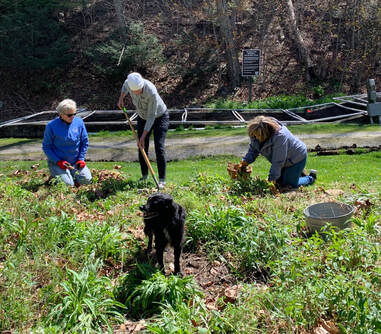 Rolling up our sleeves to clear weeds and allow natives to push through. Rascal, Debbie Harkrader’s pooch was protect overseer. Photo by Karen Cowen.
Rolling up our sleeves to clear weeds and allow natives to push through. Rascal, Debbie Harkrader’s pooch was protect overseer. Photo by Karen Cowen. Central Blue Ridge Master Naturalists Team Up to Help Three Sponsoring Agencies
--Contributed by Bette Dzamba and Linda Hughes, VMN Central Blue Ridge Chapter
VMN volunteers from the Central Blue Ridge Chapter have come together this spring for three different activities with our sponsoring agencies.
For a second year, chapter volunteers pitched in to maintain the Montebello Fish Hatchery Pollinator Garden. The garden was established in 2018 as a collaboration between the Virginia Department of Wildlife Resources (VDWR), Montebello Community volunteers and some participants from the local chapters of Master Naturalists and Master Gardeners. The garden comprises two small beds of native plants near the hatchery’s visitor car park and pavilion and is part of VDWR’s education/outreach program. Since its establishment, the garden upkeep had been done by friends of the hatchery, and for two years now CBR jumped in to lend a hand. On April 22, 5 CBRMNs joined local volunteers to weed the beds and reduce the coverage of Rosa carolina and Rudbekia fulgida. Thinned out plants were donated to the Mallory Creek Wildlfower Garden at RVCC (a joint project of CBRMN, Nelson County Master Gardeners Association and RVCC): Heart-Leaved Aster, Black-eyed Susan, Spiderwort, Yarrow and Pasture Rose (thorns included).
--Contributed by Bette Dzamba and Linda Hughes, VMN Central Blue Ridge Chapter
VMN volunteers from the Central Blue Ridge Chapter have come together this spring for three different activities with our sponsoring agencies.
For a second year, chapter volunteers pitched in to maintain the Montebello Fish Hatchery Pollinator Garden. The garden was established in 2018 as a collaboration between the Virginia Department of Wildlife Resources (VDWR), Montebello Community volunteers and some participants from the local chapters of Master Naturalists and Master Gardeners. The garden comprises two small beds of native plants near the hatchery’s visitor car park and pavilion and is part of VDWR’s education/outreach program. Since its establishment, the garden upkeep had been done by friends of the hatchery, and for two years now CBR jumped in to lend a hand. On April 22, 5 CBRMNs joined local volunteers to weed the beds and reduce the coverage of Rosa carolina and Rudbekia fulgida. Thinned out plants were donated to the Mallory Creek Wildlfower Garden at RVCC (a joint project of CBRMN, Nelson County Master Gardeners Association and RVCC): Heart-Leaved Aster, Black-eyed Susan, Spiderwort, Yarrow and Pasture Rose (thorns included).
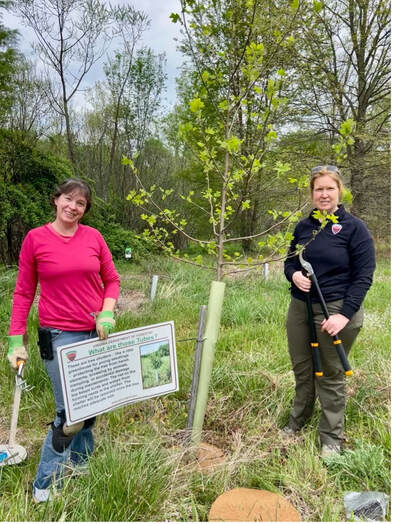 Master naturalist Lisa Caltabiano and DoF’s Deya Ramsden cut away a tree shelter from a healthy Liriodendron (Tulip Poplar). Photo by Linda Hughes.
Master naturalist Lisa Caltabiano and DoF’s Deya Ramsden cut away a tree shelter from a healthy Liriodendron (Tulip Poplar). Photo by Linda Hughes. Chapter members also joined hands with the Department of Forestry on April 17 to fortify the Riparian Buffer at Rockfish Valley Foundation. In addition to pulling and bagging Garlic Mustard, they cleared weeds, checked tree tubes, and laid down coco fiber mat weed barriers for 100 native trees and shrubs!
This project is part of a joint multi-year undertaking by Mary Voorhees, Rivanna Master Naturalist and Linda Hughes, CBR chapter to restore the biodiversity of Rockfish Valley Foundation’s natural spaces.
This workday is a part of a multi-year plan to manage invasives at the RVF trails system spearheaded by Mary and Linda in partnership with Rockfish Valley Foundation, the Department of Forestry, and Blue Ridge PRISM.
This project is part of a joint multi-year undertaking by Mary Voorhees, Rivanna Master Naturalist and Linda Hughes, CBR chapter to restore the biodiversity of Rockfish Valley Foundation’s natural spaces.
This workday is a part of a multi-year plan to manage invasives at the RVF trails system spearheaded by Mary and Linda in partnership with Rockfish Valley Foundation, the Department of Forestry, and Blue Ridge PRISM.
 Animal crafts at the James River State Park Earth Day event. Photo by Bette Dzamba.
Animal crafts at the James River State Park Earth Day event. Photo by Bette Dzamba. CBR volunteers also joined fellow master naturalists from the Central Virginia and Rivanna chapters, 4-H, and State Park volunteers to celebrate Earth Day at James River State Park. Approximately 50 park visitors stopped by to enjoy several hands-on exhibits.
Our chapter Vice President Bette Dzamba and fellow member, David Sellers staffed the chapter tables. Interested visitors to the Central Blue Ridge tables used a microscope to get a close-up view of the teeming life in pondwater and the intricate structures of leaves, flowers, fungi and lichens. Some visitors even used recycled egg cartons and toilet paper rolls to create some of their favorite Virginia wildlife.
Other chapters had displays on blue bird boxes, sounds and images of frogs, bears, and the importance of protecting our watersheds and night skies.
Our chapter Vice President Bette Dzamba and fellow member, David Sellers staffed the chapter tables. Interested visitors to the Central Blue Ridge tables used a microscope to get a close-up view of the teeming life in pondwater and the intricate structures of leaves, flowers, fungi and lichens. Some visitors even used recycled egg cartons and toilet paper rolls to create some of their favorite Virginia wildlife.
Other chapters had displays on blue bird boxes, sounds and images of frogs, bears, and the importance of protecting our watersheds and night skies.
 Judy Kinshaw-Ellis receives the James City County Volunteer Lifetime Achievement Award from Alister Perkins, James City County Parks Administrator and VMN in the Historic Rivers Chapter.
Judy Kinshaw-Ellis receives the James City County Volunteer Lifetime Achievement Award from Alister Perkins, James City County Parks Administrator and VMN in the Historic Rivers Chapter. Judy Kinshaw-Ellis Recognized for Lifetime Achievement
--Contributed by Janet Harper and Judy Jones
Each year James City County holds a volunteer recognition reception in which it honors volunteers from all corners of the county. At this time, they also announce James City County Volunteer Lifetime Achievement Award recipient. This year, on April 24th, it was awarded to our own Judy Kinshaw-Ellis. This is the highest volunteer honor that can be given within the county and Judy is only the second recipient of the accolade. Alister Perkinson, JCC Parks Administrator and – coincidently – a Historic Rivers Chapter member, presented the award to her. He highlighted so many of her service achievements and went on to say that it was fortunate that this award is given so close to Earth Day and Arbor Day celebrations as Judy holds the record for planting the most trees in James City County Parks – over 3,000! As a Virginia Master Naturalist with the Historic Rivers Chapter and also a Master Gardener, Judy has, over the past decade, worked countless volunteer hours in our James City County parks. Some of the highlights include a Master Gardener Tree Steward project where she researched and planted native and historically accurate trees around the Free Black Settlement. The planting area, along with the Williamsburg Botanical Garden, was later recognized as a level 1 arboretum by the ArbNet accreditation program.
Judy also spearheaded a new outdoor classroom at Freedom Park, helping to write a grant to the Virginia Department of Forestry to cover over $6,000 of the cost to construct the classroom. She also worked to install plantings around the area, and even conducted programs in the classroom when it was complete!
Most recently, Judy has been working on creating a riparian garden at Brickyard Landing Park, a demonstration garden for park visitors to learn about plants to help with erosion and stormwater runoff on their properties. To date Judy and her Historic Rivers team have planted over 400 trees, shrubs, perennials, and grasses at Brickyard Landing, and has received over $15,000 in grants for the plant material and signage, all at no cost to the County. Along the way she has planted countless trees and pollinator plants in our parks, and has truly made our community a better, more sustainable place. Judy Kinshaw-Ellis is a volunteer who wholeheartedly believes in our VMN goals and mission and is constantly pushing us to improve. We are thrilled that Judy has received this highly deserved recognition because, as a Master Naturalist, a Master Gardener and a “Master Volunteer”, she is truly making a difference in our community.
--Contributed by Janet Harper and Judy Jones
Each year James City County holds a volunteer recognition reception in which it honors volunteers from all corners of the county. At this time, they also announce James City County Volunteer Lifetime Achievement Award recipient. This year, on April 24th, it was awarded to our own Judy Kinshaw-Ellis. This is the highest volunteer honor that can be given within the county and Judy is only the second recipient of the accolade. Alister Perkinson, JCC Parks Administrator and – coincidently – a Historic Rivers Chapter member, presented the award to her. He highlighted so many of her service achievements and went on to say that it was fortunate that this award is given so close to Earth Day and Arbor Day celebrations as Judy holds the record for planting the most trees in James City County Parks – over 3,000! As a Virginia Master Naturalist with the Historic Rivers Chapter and also a Master Gardener, Judy has, over the past decade, worked countless volunteer hours in our James City County parks. Some of the highlights include a Master Gardener Tree Steward project where she researched and planted native and historically accurate trees around the Free Black Settlement. The planting area, along with the Williamsburg Botanical Garden, was later recognized as a level 1 arboretum by the ArbNet accreditation program.
Judy also spearheaded a new outdoor classroom at Freedom Park, helping to write a grant to the Virginia Department of Forestry to cover over $6,000 of the cost to construct the classroom. She also worked to install plantings around the area, and even conducted programs in the classroom when it was complete!
Most recently, Judy has been working on creating a riparian garden at Brickyard Landing Park, a demonstration garden for park visitors to learn about plants to help with erosion and stormwater runoff on their properties. To date Judy and her Historic Rivers team have planted over 400 trees, shrubs, perennials, and grasses at Brickyard Landing, and has received over $15,000 in grants for the plant material and signage, all at no cost to the County. Along the way she has planted countless trees and pollinator plants in our parks, and has truly made our community a better, more sustainable place. Judy Kinshaw-Ellis is a volunteer who wholeheartedly believes in our VMN goals and mission and is constantly pushing us to improve. We are thrilled that Judy has received this highly deserved recognition because, as a Master Naturalist, a Master Gardener and a “Master Volunteer”, she is truly making a difference in our community.
 VMN volunteers with James City County Parks Administrator (left). Photo by VMN Historic Rivers Chapter.
VMN volunteers with James City County Parks Administrator (left). Photo by VMN Historic Rivers Chapter. Historic Rivers Master Naturalists Help Increase Accessibility in James City County Parks
The Historic Rivers Chapter’s Diversity, Equity, and Inclusion team is proud to have completed one of its accessibility objectives in March 2024. As part of the chapter’s “birdability” project, eleven new benches were installed around the main part of Williamsburg’s Greenspring’s Interpretive Trail, making it more accessible to individuals with limited mobility. The ADA-compliant seats are designed for easy wheelchair access and are spaced along the trail based on ADA recommendations.
The DEI team coordinated with James City County (JCC) to plan and implement this project. We owe a special thanks to committee member Suzanne Stern who was instrumental in obtaining a grant from the Patrick P. Lee Foundation to fund the majority of the project. Master Naturalist volunteers and members of the JCC Parks and Recreation staff worked together to install the benches. According to Alister Perkinson, parks administrator, JCC has decided to use this type of bench in all its future installations.
The Historic Rivers Chapter’s Diversity, Equity, and Inclusion team is proud to have completed one of its accessibility objectives in March 2024. As part of the chapter’s “birdability” project, eleven new benches were installed around the main part of Williamsburg’s Greenspring’s Interpretive Trail, making it more accessible to individuals with limited mobility. The ADA-compliant seats are designed for easy wheelchair access and are spaced along the trail based on ADA recommendations.
The DEI team coordinated with James City County (JCC) to plan and implement this project. We owe a special thanks to committee member Suzanne Stern who was instrumental in obtaining a grant from the Patrick P. Lee Foundation to fund the majority of the project. Master Naturalist volunteers and members of the JCC Parks and Recreation staff worked together to install the benches. According to Alister Perkinson, parks administrator, JCC has decided to use this type of bench in all its future installations.
 Southern Piedmont Master Naturalist volunteer John Gibbs delivering outreach program at Occoneechee State Park. Photo by Terri Mewborn.
Southern Piedmont Master Naturalist volunteer John Gibbs delivering outreach program at Occoneechee State Park. Photo by Terri Mewborn. Southern Piedmont Master Naturalist Bluebird Teams
Southern Piedmont Master Naturalists have built active bluebird monitoring programs at all three of their local state parks—Occoneechee, Staunton River, and Staunton River Battlefield State Parks.
Visitors to the three parks are treated to walkable bluebird trails where they can observe the comings and goings of these special birds during the busy breeding season which typically runs from April through August. Bluebirds in Virginia’s Southern Piedmont region may have as many as three broods during a season, so there’s never a dull moment. Occoneechee’s Team Leader, John Gibbs, loves to spread the word, “If you haven’t been introduced to the beautiful Eastern Bluebird, their habits, and songs, you’ll want to come learn how friendly and interactive this species is…and experience the joy of watching them and their fledges as they go in and out of the new nesting boxes.”
The chapter’s bluebird projects began at Occoneechee last year. The park had 11 deteriorating bluebird boxes that were in a state of disrepair and were not managed or monitored. Working with the Virginia Bluebird Society, Occoneechee park staff, and in concert with the “Friends of Occoneechee” citizen support organization, the VMN team installed new boxes and now maintain 20 nesting boxes, built to unique specifications that encourage bluebirds and discourage interlopers such as cats, racoons, and snakes.
The bluebird trail project at Occoneechee proved so successful that chapter members recently expanded to Staunton River Battlefield State Park. In January, the team installed 10 bluebird box stations. The trail is shorter at this park and very easily walkable or even drivable. This provides a meaningful bluebird experience for visitors who may not be able to walk the longer bluebird trail at Occoneechee.
Most recently, team member Eleanor Knowlson, a long-time bluebird enthusiast, expanded the chapter’s bluebird project further by stepping in to monitor 18 nesting boxes at Staunton River State Park.
In addition to maintaining nesting boxes, Southern Piedmont Master Naturalists inspect and monitor the nesting boxes every week from April through September. Using a strict scientific protocol, they carefully document how many nests are built in the boxes, number of eggs laid, how many hatch, and how many hatchling fledge. They send the data to the Virginia Bluebird Society, which consolidates data statewide and along with the North American Bluebird Society, promotes bluebird research and conservation. In the 1970s, Eastern Bluebird populations had declined as much as 90%. Now thriving, Eastern Bluebirds have rebounded, and efforts of many dedicated volunteers help ensure these birds continue to thrive. Occoneechee State Park Assistant Manager Austin Peightel points out that “Virginia’s State Parks, which fall under the Department of Conservation and Recreation (DCR), have a mission to conserve the natural, scenic, historic and cultural resources of the Commonwealth, and provide recreational and educational opportunities consistent with the good stewardship.” Peightel says that partnership with Master Naturalist volunteers help with all of this—stewardship, conservation, and public access.
The chapter’s bluebird teams are offering public educational programs at Occoneechee State Park and Staunton River Battlefield State Park this spring and hold related programs on bluebirds and bluebird box maintenance throughout the year. Staunton River State Park is advertising an ongoing invitation to the public to observe VMN Eleanor’s bluebird monitoring once a month.
Connecting visitors to Virginia’s bountiful nature and natural resources is good for the birds and for the people, and partnering with the state parks is a priority for the Southern Piedmont chapter.
Southern Piedmont Master Naturalists have built active bluebird monitoring programs at all three of their local state parks—Occoneechee, Staunton River, and Staunton River Battlefield State Parks.
Visitors to the three parks are treated to walkable bluebird trails where they can observe the comings and goings of these special birds during the busy breeding season which typically runs from April through August. Bluebirds in Virginia’s Southern Piedmont region may have as many as three broods during a season, so there’s never a dull moment. Occoneechee’s Team Leader, John Gibbs, loves to spread the word, “If you haven’t been introduced to the beautiful Eastern Bluebird, their habits, and songs, you’ll want to come learn how friendly and interactive this species is…and experience the joy of watching them and their fledges as they go in and out of the new nesting boxes.”
The chapter’s bluebird projects began at Occoneechee last year. The park had 11 deteriorating bluebird boxes that were in a state of disrepair and were not managed or monitored. Working with the Virginia Bluebird Society, Occoneechee park staff, and in concert with the “Friends of Occoneechee” citizen support organization, the VMN team installed new boxes and now maintain 20 nesting boxes, built to unique specifications that encourage bluebirds and discourage interlopers such as cats, racoons, and snakes.
The bluebird trail project at Occoneechee proved so successful that chapter members recently expanded to Staunton River Battlefield State Park. In January, the team installed 10 bluebird box stations. The trail is shorter at this park and very easily walkable or even drivable. This provides a meaningful bluebird experience for visitors who may not be able to walk the longer bluebird trail at Occoneechee.
Most recently, team member Eleanor Knowlson, a long-time bluebird enthusiast, expanded the chapter’s bluebird project further by stepping in to monitor 18 nesting boxes at Staunton River State Park.
In addition to maintaining nesting boxes, Southern Piedmont Master Naturalists inspect and monitor the nesting boxes every week from April through September. Using a strict scientific protocol, they carefully document how many nests are built in the boxes, number of eggs laid, how many hatch, and how many hatchling fledge. They send the data to the Virginia Bluebird Society, which consolidates data statewide and along with the North American Bluebird Society, promotes bluebird research and conservation. In the 1970s, Eastern Bluebird populations had declined as much as 90%. Now thriving, Eastern Bluebirds have rebounded, and efforts of many dedicated volunteers help ensure these birds continue to thrive. Occoneechee State Park Assistant Manager Austin Peightel points out that “Virginia’s State Parks, which fall under the Department of Conservation and Recreation (DCR), have a mission to conserve the natural, scenic, historic and cultural resources of the Commonwealth, and provide recreational and educational opportunities consistent with the good stewardship.” Peightel says that partnership with Master Naturalist volunteers help with all of this—stewardship, conservation, and public access.
The chapter’s bluebird teams are offering public educational programs at Occoneechee State Park and Staunton River Battlefield State Park this spring and hold related programs on bluebirds and bluebird box maintenance throughout the year. Staunton River State Park is advertising an ongoing invitation to the public to observe VMN Eleanor’s bluebird monitoring once a month.
Connecting visitors to Virginia’s bountiful nature and natural resources is good for the birds and for the people, and partnering with the state parks is a priority for the Southern Piedmont chapter.
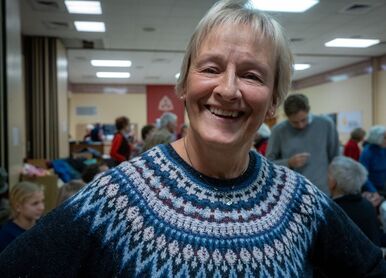 Carol Kauffman, VMN volunteer in the New River Valley Chapter. Photo by Tonia Moxley.
Carol Kauffman, VMN volunteer in the New River Valley Chapter. Photo by Tonia Moxley. Carol Kauffman: working for the bears, birds, and benthic organisms
This spring has been busy for New River Valley Master Naturalist Carol Kauffman.
She once again organized a cadre of volunteers from our chapter and the NRV Bird Club to monitor the 25-year-old Bluebird Trail at the Virginia Tech Corporate Research Center. The team records weekly data from 18 nestboxes from March through August and reports it to the Cornell Laboratory of Ornithology and the Virginia Bluebird Society.
Not only that. Carol led new efforts this winter and spring to:
Carol has been a member of our chapter since 2020, and has so far contributed 705 lifetime hours to the program. She works with our members and other local and state organizations, such as the Virginia Bluebird Society, to help conserve our natural resources and deepen the public's appreciation of the nature around them. She's been a mentor to many of us. We are grateful for her dedication and proud that she is one of 113 active NRV chapter members.
This spring has been busy for New River Valley Master Naturalist Carol Kauffman.
She once again organized a cadre of volunteers from our chapter and the NRV Bird Club to monitor the 25-year-old Bluebird Trail at the Virginia Tech Corporate Research Center. The team records weekly data from 18 nestboxes from March through August and reports it to the Cornell Laboratory of Ornithology and the Virginia Bluebird Society.
Not only that. Carol led new efforts this winter and spring to:
- organize a regional Virginia Save Our Streams certification event on March 16 that has spawned at least two new stream teams to monitor water quality in Giles and Montgomery counties. A total of eight NRVMN members were certified that day and, along with our existing stream teams, will have a big impact on our water quality work.
- spearheaded the formation of our first Living With Bears education team, bringing this important Department of Wildlife Resources education program to the New River Valley.
- applied for and received a $500 grant from Sustainable Blacksburg to fund our outreach at 2024 festivals around the NRV to educate the public on avoiding bear-human conflicts.
- led the team that gave our chapter's first public Living with Bears presentation at a March 27 Sustainable Blacksburg "Lunch and Learn" event. More are planned.
Carol has been a member of our chapter since 2020, and has so far contributed 705 lifetime hours to the program. She works with our members and other local and state organizations, such as the Virginia Bluebird Society, to help conserve our natural resources and deepen the public's appreciation of the nature around them. She's been a mentor to many of us. We are grateful for her dedication and proud that she is one of 113 active NRV chapter members.
 Gary Shinners working with fellow members of the Arlington Regional Master Naturalists.
Gary Shinners working with fellow members of the Arlington Regional Master Naturalists. Arlington Regional Master Naturalist Chapter Recognizes Gary Shinners
--Contributed by Susan Berry, VMN Arlington Regional Chapter
In 2021, Gary Shinners (Arlington Regional Chapter) initiated a program in which the ARMN chapter would partner with the Arlington Offender Aid and Restoration (OAR) organization. Since then, OAR has referred to Gary individuals who are required to earn community service hours because of minor, nonviolent infractions. These individuals have been contributing significant volunteer hours in Arlington’s parks while satisfying their community service obligations. In addition to providing the OAR participants with an opportunity to satisfy their service hour requirements, working with Park Stewards and other ARMN members in the parks has provided participants with a direct experience of nature that many had not previously enjoyed. Park Stewards have observed that the participants appear to truly value this type of service work and also that the participants are some of our hardest working volunteers.
Since the start of the partnership, Gary has worked with a couple hundred individuals, who have collectively contributed thousands of volunteer hours with ARMN. Recently, Gary reached out to other members of ARMN to request assistance with his OAR contacts. Gary reports that the coordinator work involves explaining the habitat restoration work to OAR volunteers, matching them with ARMN habitat restoration work, following up with Park Stewards to confirm participation, and sending regular emails to OAR to confirm completion of service hours. Spanish skills are particularly valuable since some OAR participants are Spanish speaking. Gary has explained that being an OAR coordinator is a great way to help our community by bringing volunteer resources to our parks, enabling participants to earn community service hours, helping them learn about our native plants and wildlife, and providing them with a valuable experience in our natural areas that they might not have enjoyed otherwise. ARMN is very appreciative of all that Gary has accomplished and looks forward to continuing the relationship between ARMN and OAR. Should other chapters want to replicate this type of arrangement, Gary can advise on how the program has worked in Arlington.
--Contributed by Susan Berry, VMN Arlington Regional Chapter
In 2021, Gary Shinners (Arlington Regional Chapter) initiated a program in which the ARMN chapter would partner with the Arlington Offender Aid and Restoration (OAR) organization. Since then, OAR has referred to Gary individuals who are required to earn community service hours because of minor, nonviolent infractions. These individuals have been contributing significant volunteer hours in Arlington’s parks while satisfying their community service obligations. In addition to providing the OAR participants with an opportunity to satisfy their service hour requirements, working with Park Stewards and other ARMN members in the parks has provided participants with a direct experience of nature that many had not previously enjoyed. Park Stewards have observed that the participants appear to truly value this type of service work and also that the participants are some of our hardest working volunteers.
Since the start of the partnership, Gary has worked with a couple hundred individuals, who have collectively contributed thousands of volunteer hours with ARMN. Recently, Gary reached out to other members of ARMN to request assistance with his OAR contacts. Gary reports that the coordinator work involves explaining the habitat restoration work to OAR volunteers, matching them with ARMN habitat restoration work, following up with Park Stewards to confirm participation, and sending regular emails to OAR to confirm completion of service hours. Spanish skills are particularly valuable since some OAR participants are Spanish speaking. Gary has explained that being an OAR coordinator is a great way to help our community by bringing volunteer resources to our parks, enabling participants to earn community service hours, helping them learn about our native plants and wildlife, and providing them with a valuable experience in our natural areas that they might not have enjoyed otherwise. ARMN is very appreciative of all that Gary has accomplished and looks forward to continuing the relationship between ARMN and OAR. Should other chapters want to replicate this type of arrangement, Gary can advise on how the program has worked in Arlington.
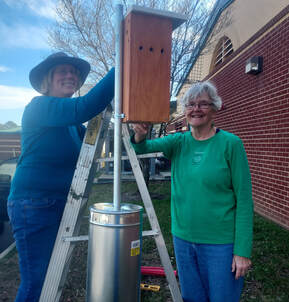 Luann Johnson and Pat Anderson install a Bluebird nest box at St. Claire Walker Middle School. Luann also serves as Middlesex County Coordinator for VBS. Photo by Charlene Talcott, State Coordinator for VBS.
Luann Johnson and Pat Anderson install a Bluebird nest box at St. Claire Walker Middle School. Luann also serves as Middlesex County Coordinator for VBS. Photo by Charlene Talcott, State Coordinator for VBS. Linking Bluebirds to Science Education on the Middle Peninsula
--Contributed by Charlene Talcott, Virginia Bluebird Society State Coordinator and VMN Northern Neck Chapter
Luann Johnson and Pat Anderson recently installed Bluebird nest boxes at St. Clare Walker Middle School and Middlesex Elementary School. A third nest box is planned for Middlesex High School. Special cameras that will transmit live images of nesting birds are planned. Students will perform scientific analysis, predictions, graphing and other STEAM techniques using the Bluebird videos as their source material. One box was occupied by Bluebirds a few days after installation. Johnson and Anderson are members of the Middle Peninsula Chapter of Virginia Master Naturalists and will provide ongoing support and monitoring of the boxes.
The nest boxes and equipment were provided through a grant from the River Counties Community Foundation received by the Virginia Bluebird Society (VBS).
--Contributed by Charlene Talcott, Virginia Bluebird Society State Coordinator and VMN Northern Neck Chapter
Luann Johnson and Pat Anderson recently installed Bluebird nest boxes at St. Clare Walker Middle School and Middlesex Elementary School. A third nest box is planned for Middlesex High School. Special cameras that will transmit live images of nesting birds are planned. Students will perform scientific analysis, predictions, graphing and other STEAM techniques using the Bluebird videos as their source material. One box was occupied by Bluebirds a few days after installation. Johnson and Anderson are members of the Middle Peninsula Chapter of Virginia Master Naturalists and will provide ongoing support and monitoring of the boxes.
The nest boxes and equipment were provided through a grant from the River Counties Community Foundation received by the Virginia Bluebird Society (VBS).
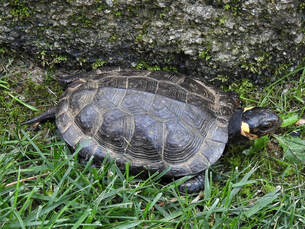 Bog turtle in Virginia. Photo by floydcams, CC BY-NC. Courtesy of iNaturalist.
Bog turtle in Virginia. Photo by floydcams, CC BY-NC. Courtesy of iNaturalist. Lending Bog Turtles a Helping Hand
--Contributed by Bruce Grimes, VMN New River Valley Chapter
Virginia Master Naturalists from two chapters (Southwestern Piedmont and New River Valley) joined with the Dan River Basin Association, the Virginia Department of Wildlife Resources, and other volunteers for an annual cleanup of bog turtle habitat at a public location in Patrick County. The annual cleanup is timed to be before nesting season for this state endangered species. Habitat loss is a significant issue for bog turtles, and these volunteers' efforts help keep their wetland habitat clear of invasive plants.
--Contributed by Bruce Grimes, VMN New River Valley Chapter
Virginia Master Naturalists from two chapters (Southwestern Piedmont and New River Valley) joined with the Dan River Basin Association, the Virginia Department of Wildlife Resources, and other volunteers for an annual cleanup of bog turtle habitat at a public location in Patrick County. The annual cleanup is timed to be before nesting season for this state endangered species. Habitat loss is a significant issue for bog turtles, and these volunteers' efforts help keep their wetland habitat clear of invasive plants.


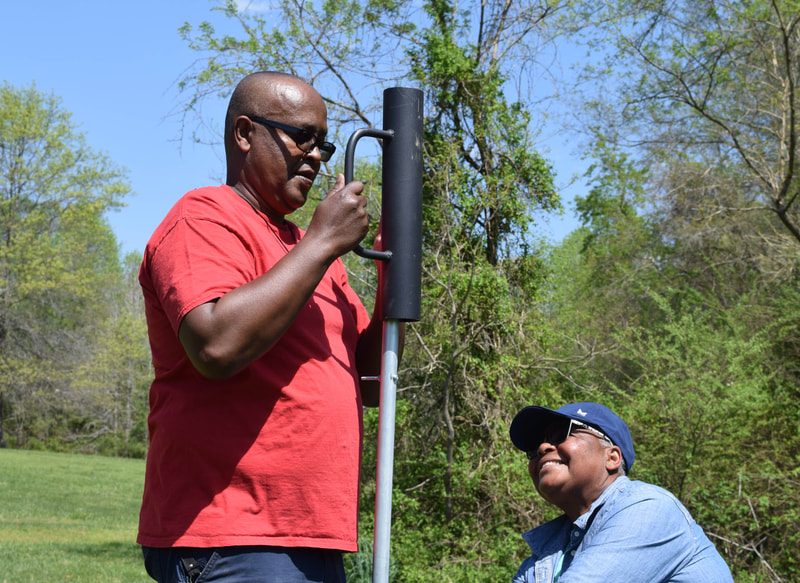
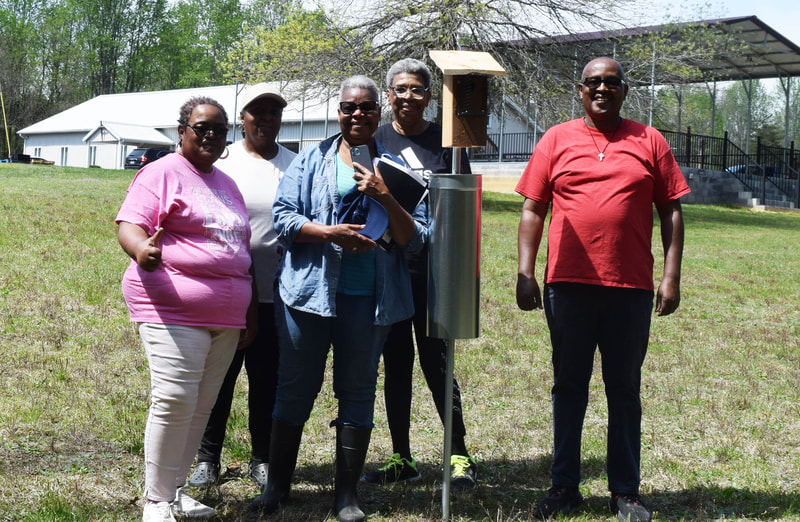

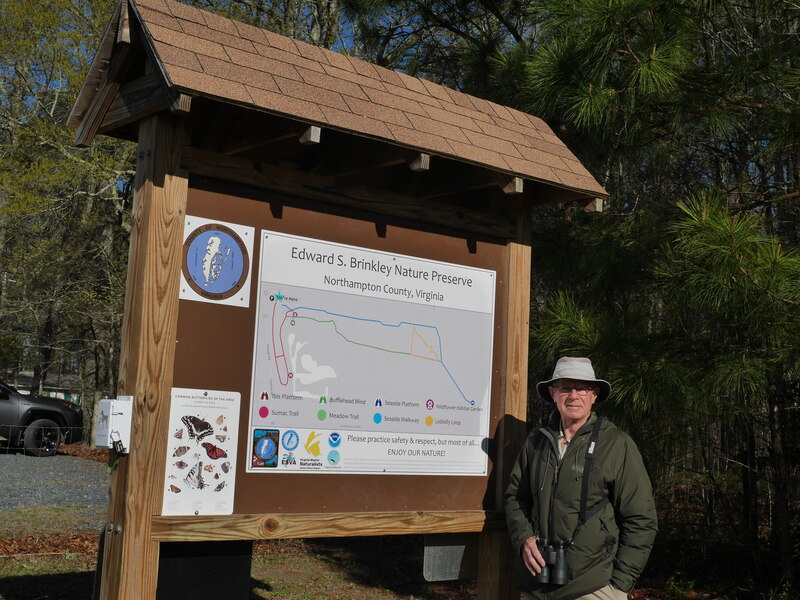



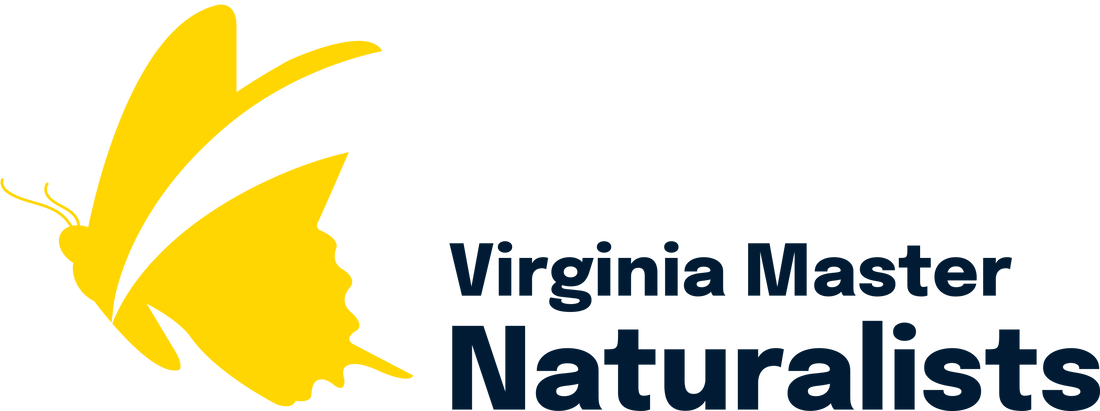
 RSS Feed
RSS Feed